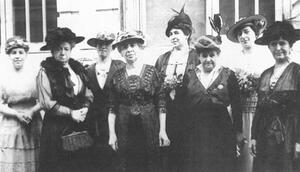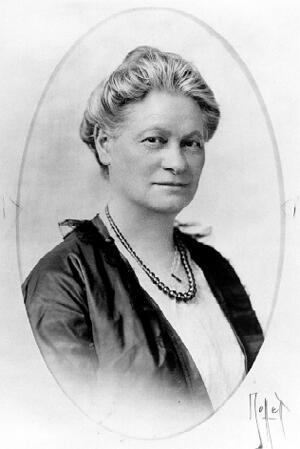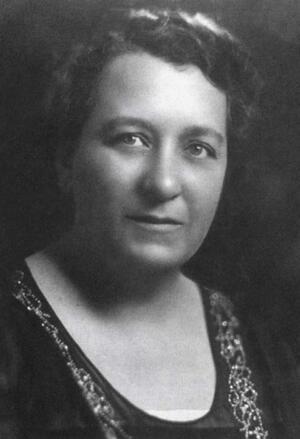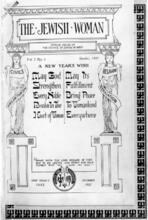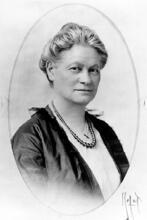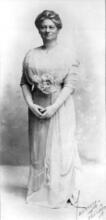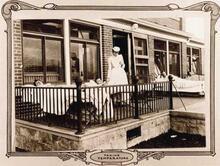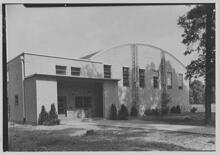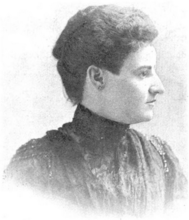Club Movement in the United States
In the challenging situation of being first-generation immigrants in rapidly changing American cities, young Jewish and usually German women formed benevolent societies in the late nineteenth century. When the daughters of the women who formed these groups became adults, they tended to marry later and have fewer children, allowing them to spend more time on social causes. Around the turn of the century, Jewish women shifted from simple benevolent work to social and personal reform, often through aiding immigrants and young, vulnerable women. They also facilitated conversations and educational opportunities to learn about Jewish history and ethics, which in turn helped inform their aid work. These efforts created a space specifically for women both married and unmarried in Jewish American society.
Jewish clubwomen emerged in America between 1880 and 1920 as part of a comprehensive social transition. Jews—women as well as men—evolved from a series of scattered ethnic enclaves primarily of German origin into a more cohesive and politically active portion of a decidedly American middle class. The activities of clubwomen were responses to the social pressures placed upon them. As the source of family nurture, they were pressured by rabbis to study the Jewish religion so they might protect their children from conversion to Christianity or a drift into atheism. As the heirs of a tradition of maternal charity, they suddenly faced an influx of immigrants whose immense economic, educational, and health care needs presented unprecedented challenges.
To meet these challenges, clubwomen refined their tradition of charitable obligation first into volunteer aid to Jewish strangers and then into formally organized and professionally administered social settlement work. They also redefined the religious and civic meaning of American Judaism. While rabbis may have encoded the tenets of Reform Judaism in documents like the Pittsburgh Platform (1885), clubwomen implemented the new emphasis on meaningful ceremonial and social reform. In addition, while rabbis may have shared pulpits with liberal Protestant ministers, Jewish clubwomen worked with Protestant social reformers like Jane Addams, Florence Kelley, and Margaret Sanger to demonstrate that the new “mission of Israel” was to make the needs of children and women part of the new Progressive political agenda.
Social and Political Setting
Even more so than in Germany and Britain, the growth of very large American cities dominated by industrial production facilitated the unprecedented migration and mobility of people. Unlike their counterparts in Germany or England, American Jewish women matured in cities that were themselves both ethnically diverse and very rapidly expanding. Without a titled elite like the Montefiores and Rothschilds in Britain or legally incorporated Jewish communities as in Central Europe to provide publicity and funding, the wives, and daughters of merchants across America organized their social circles to create institutions to direct newcomers. They were forced by the new scale of life, by the very magnitude of impoverished immigrant communities, to extend familial protection to strange women and children.
The political context within which clubwomen organized shaped the gender roles they redefined and the programs they offered to their new clients. While their clubs grew from different cultural traditions than those of upper-middle-class Protestant women, they were part of an effort by elite women to assert their own autonomy while learning to understand and working to resolve the problems of newcomers. American Jewish clubwomen were not so much being afforded entry to an ongoing bourgeois culture as being asked to share in an effort by elite women to manage a shift in life’s scale and cultural diversity. Nevertheless, they differed from Protestant clubwomen in being culturally akin to the clients toward whom their efforts were directed. While sharing many class interests with Protestant clubwomen, they remained institutionally separate and socially absorbed in the Jewish community.
To appreciate the rapid and complex shift in gender roles forged by clubwomen, it is first helpful to examine the ethnic setting from which clubwomen emerged. Clubwomen were generally the daughters of immigrant German Jews who had scattered across the United States. Most of their fathers were merchants or artisans along the major American trade routes, from New York to New Orleans and San Francisco. Their mothers were usually the daughters of village families, who were accustomed to frequent childbearing and responsibility for large households. In German hometowns, Jewish families were usually legally organized into a self-supporting community. Charity was the responsibility of the gemeinde, or community, supplemented by women who volunteered to assist poor families personally and materially.
In the United States, German Jewish immigrant women continued some of the traditions of their hometowns. They tended to marry young to men considerably older than themselves and to have large families. As the wives of merchants, however, they could afford to hire servants to help care for their own children. But since the Jewish communities were not legal entities, the women had to form benevolent societies to assist one another with emergency household needs. Care of sick women and their children, burial of the dead, and raising funds to send widows and young children back to their paternal families were all part of the personal service immigrant women gave to one another. In small towns, Ladies Hebrew Benevolent Societies held annual Strawberry Festivals or sponsored whist parties to help pay the mortgage and provide accessories for the synagogue.
By the late 1880s, the ladies benevolent societies in larger cities had to respond to the needs of Eastern European families who were complete strangers. The immigrants lived in a distant part of an enlarged city, spoke a different language (Yiddish rather than German or English), practiced a variant form of Judaism, and had different family traditions. The women of the benevolent society saw the immigrant families as being at the starting point of a process that combined acculturation to American social norms and liberalization of Jewish identity. As the newcomers proliferated, the benevolent society assigned a member to visit their homes in the immigrant district to ascertain the extent of family needs.
By the mid-1880s, the daughters of benevolent society families had become adults. They had assimilated an American bourgeois style of young womanhood, which usually included the equivalent of a high school education, perhaps family vacations in Germany, and a smattering of knowledge about the Old Testament. Unlike their mothers, they saw no need to marry in their teens or very early twenties, or to have large families. Manuscript census data for cities like Portland, Oregon; Galveston, Texas; and Charleston, South Carolina in 1900 and 1910 show that American-born Jewish women under age forty created a family pattern similar to that of their Protestant peers. On the average, these women married in their mid-twenties to men four to seven years older than themselves and usually had only two or three children. The family usually owned its home and had a servant to help with family chores. In addition, over 20 percent of women in their thirties in these sample cities were unmarried at a time when many American college-educated women did not marry.
For these women, Jewishness usually meant a sense of communal responsibility for charity work combined with a broader knowledge of secular literary issues. Women like Henrietta and Hannah Solomon were not only active members of the Reform Temple Sinai but also the first Jewish women invited to join the Chicago Woman’s Club in 1877. By 1887, Jennie Franklin Purvin and her friends formed the Chicago Women’s Aid, initially to visit the Jewish sick at Michael Reese Hospital. But their interests soon expanded. As Jewish matriarchs, they raised money to expand Michael Reese Hospital and to bring Jewish nurses to Chicago. As genteel American women, they formed study circles to discuss literature like the work of George Eliot.
Young Womanhood
In Charleston, South Carolina, in 1889, Rabbi David Levy and the married women of the Reform Congregation Beth Elohim adapted, on a small scale, the idea of women’s communal responsibility to meet new social conditions. The young, unmarried women of the congregation desired to use their time more productively, while city authorities observed an influx of poor Jews with social needs. So forty-five unmarried sisters and cousins from age sixteen into their early thirties formed a club called the Happy Workers “to care for as many poor [Jewish] children as the funds will allow.” As some of the women married, they retained membership, but motions in the 1890s to open the club to married women or to admit girls under age sixteen were defeated.
For Charleston to have poor Jewish children must have been a startling anomaly. In 1880, only a handful of Eastern European Jews lived in the city, and most of these had successful businesses. A few daughters from these families even belonged to the Happy Workers. But after 1890, several hundred Eastern European Jewish families arrived and settled among poor African Americans living near the wharves along North King Street. The Happy Workers formed committees to visit these newcomers. A few widows or deserted wives and their children were temporarily “adopted,” with the women given medical care and the children given clothing, medicine, or eyeglasses.
The context within which this charity was given, however, reflected the class tensions that cut through ethnic loyalties. The Happy Workers’ meetings combined routine business and sewing of garments for their wards with moralistic discussions of women who were not responding appropriately to the proffered aid. Some women were judged incapable of budgeting funds properly, while other “clients” balked at classes in sewing that were supposed to make them self-sufficient. More than one client informed the Happy Workers that she no longer wished to receive support.
Over the years, the Happy Workers accumulated a small endowment and contributed to projects like kindergartens or night school classes for Jewish children and women. As the era of extensive spinsterhood came to an end, the Happy Workers amended their charter and accepted married members, but they continued to think of their work as genteel charity. They did not see themselves acquiring professional expertise, affiliating with Protestant women with similar goals, or interacting in some formal way with civil authorities. The Happy Workers had developed a very traditional outlet for a new Jewish social stratum—unmarried, genteelly educated young women—but it did not connect them to the larger world of professionalized acculturation and social control that young women in larger, more dynamic cities felt able to build.
"Personal Service"
Sadie American was a driving force behind the National Council of Jewish Women.
Courtesy of Project Gutenberg
A more comprehensive program to meet the needs of poor newcomers was organized by women at the Reform Temple Emanuel in San Francisco. In 1893, the depression left many immigrants, including Eastern European Jews, unemployed. Rabbi Jacob Voorsanger encouraged the women of his congregation to form a Sisterhood for Personal Service to provide immediate relief and to help men and women find work. The term “personal service” symbolized a step away from simple benevolence toward self-conscious social and personal reform. As used by Robert Woods of Boston, the leading theorist of settlement work, it referred to the way college graduates would reside among immigrants to gather accurate data on their social pathologies and to bring to them knowledge about modern urban services.
Personal service would help reintegrate a crumbling social order. But for Sadie American, a resident social worker at the Maxwell Street Settlement who would soon help found the National Council of Jewish Women, it connoted the reintegration of a confused Jewish identity. For her, personal service extended beyond benevolence by requiring socially comfortable Jewish women to study Jewish history and ethics, so they might understand their responsibility for reknitting a fragmented ethnic community. As clubwoman Seraphine Pisko, a fund-raiser and later chief administrator of the National Jewish Hospital in Denver, noted, personal service meant learning about the Jewish past as personified in the immigrants, as much as it meant bringing to immigrants America’s ideas about individualism, citizenship, and health care.
In San Francisco, the Emanu-el Sisterhood for Personal Service soon developed broad plans. Unlike the Happy Workers, the sisterhood consisted of married women with well-established social roles. But in a cosmopolitan city, they faced an apparently permanent problem of acculturating an unprecedented number of Jewish strangers. Even as the depression abated, they turned their club to meet the long-term needs of immigrants. By 1897, they acquired a building in the immigrant district, where mothers could find childcare while they were instructed in modern ideas about heath care, nutrition, and child rearing. Members of the sisterhood also intended to intervene in the child-rearing process. They organized a club for the daughters of immigrant families, and they allowed Sidney Peixoto, the son of Temple Emanuel’s president, to organize a similar club for boys. The boys, especially, were to receive vocational instruction not yet available in the public schools, as well as practical lessons in civic participation.
As a woman’s club, the sisterhood assumed responsibility for what they saw as a permanent problem—the protection of young Jewish women who lacked families. The newly organized Council of Jewish Women in New York would soon focus on the lures of prostitution to young Jewish girls. But the sisterhood in San Francisco took responsibility for girls released at age sixteen from the regional Jewish orphan home maintained by the district lodge of the B’nai B’rith. The sisterhood helped them find work, rented a house to shelter them, and then constructed a new building that by 1920 could house about thirty-three young women at a time.
During 1921, for example, seventy-one girls were accommodated, and fifty-seven more had to be turned away. The responsibility for supervising the home and for providing additional classes in personal hygiene, nutrition, home finance, and child rearing fell on the resident social worker. In 1916, Ethel Feinemen, who had been trained in social work by Jacob Billikopf in Kansas City and had spent a year at the University of Chicago and at Hull House, was hired as the first Jewish full-time resident social worker on the West Coast. In a little over twenty years, the sisterhood had learned the difference between ladies’ philanthropy and professional social work.
The Club Movement
Institutionalized club work among Jewish women received national coordination in the formation of the National Council of Jewish Women in 1893. During preparation for the Chicago World’s Fair, Hannah Solomon was invited to organize a Jewish Women’s Congress under the auspices of the World’s Parliament of Religions. She did so because rabbis had neglected Jewish women when organizing presentations on Judaism. But she decided to hold the Jewish Women’s Congress in the Religion Building rather than in the Women’s Building in order to avoid confronting the issue of women’s rights within Judaism. Instead, Jewish women demonstrated their professional expertise in discussing cultural and social issues. Women spoke not only about themes that reinforced traditional roles, like “Women in the Bible” and “Religion in the Home,” but also about “Women as Wage Workers” and “Women Protesting Persecution.”
Equally important, single women with training as schoolteachers and social workers, like Julia Richman, Julia Felsenthal, and Sadie American, gave major addresses. American’s address summarized and rebutted the criticisms of women’s new club work and explained why the Jewish community needed the new work of women beyond the home and the sisterhood. Women, she conceded, did and would do different work from men, but where men refused to see problems, women had to act. At the same time, Jews in America were and would remain a separate cultural entity, and Jewish women needed to organize to help immigrant women and children adjust. To provide this leadership, American Jewish women, through their local social networks, needed to understand how Jewish heroes had taken the initiative in the past and how they now could be guided to study and resolve modern problems.
After the World’s Fair, Solomon and American organized the National Council of Jewish Women. They hoped to interest women’s networks all over the country to initiate study circles that would turn Reform Judaism to social activism on behalf of women and children. By 1896, fifty council sections had enrolled four thousand members. At first, the sections differed from the benevolent societies or ladies aid work because of the study circles. In fact, at first a number of council sections felt that social service was the responsibility of the Ladies Aid, while their responsibility was to read and study.
But unlike the reading circles at early Protestant women’s clubs, the council sections revitalized the members’ religious and cultural identity. This focus was, in part, a response to the charge from rabbis that Jewish women were neglecting the religious education of their children. But the context of club work, in expanding cities with impoverished Jewish immigrants, soon led energized women to refocus on the social problems to which American had first pointed.
Bridging the Generation Gap
The council sections, though dominated by married women, welcomed unmarried women as well. Council organizers could see through the work of American and Felsenthal that guidance for immigrants should be entrusted to women with formal education and expertise, not only to those who had raised their own families. The small section organized in Seattle in 1900 had a large majority of married women, but of the new women recruited between 1901 and 1906, half were unmarried. By 1906, in a much larger section in San Francisco, 20 percent of the 621 members were unmarried.
Generally, single women were more sensitive to the new directions in women’s lives. In San Francisco, for example, Jessica Peixotto, who had just earned a doctorate in sociology at the University of California with a dissertation on European socialism, led the Philanthropic Committee through comprehensive readings on the English Poor Laws and on Engels’s study of slum housing in London. In 1901, the Terre Haute section listened to a paper by Helen Arnold on “The Continued Misconception of a Woman’s True Sphere.” A discussion followed in which each member was required to express her views. Regrettably, no transcript survives, but the minutes suggest that members were searching for alternative projects to augment their goals.
As the sections turned to settlement work, in part to combat the influence of Protestant “missions” to immigrant districts, a rough division of labor occurred between the older married women and the younger unmarried women. Older women usually taught domestic skills, while unmarried women organized clubs for boys and girls, taught Sunday school classes, and organized the religious ceremonies that highlighted their version of an Americanized Judaism. They also seemed more resilient in coping with the disrespect they occasionally encountered in the settlement houses from adolescent boys in immigrant families.
As the settlement work of the council sections became more sophisticated, married women usually acted as liaisons with public agencies like schools and city councils, and as “friendly visitors” in the homes of families whose children were under the jurisdiction of the juvenile courts. A network of unmarried women was encouraged to acquire professional training and usually provided the medical, dietetic, and “case work” expertise utilized to instruct immigrant women and their daughters.
By 1920, the Council of Jewish Women represented the epitome of what Jewish clubwomen had hoped to achieve. Their national leaders like American and Belle Moskowitz were recognized as experts on the causes of prostitution, while the council sections had established clubs and other family support services to prepare young women for employment and motherhood. Local and national federations of women’s clubs expected the officers of council sections to speak for the Jewish community on social welfare issues. Within the Jewish community, council sections had bridged the generation gap. They had defined honorable work for unmarried young women by creating a network that led from volunteer social service to professional social work. They were also safeguarding Judaism as a modern, ceremonially focused religious community in which women could play as distinctive a role as men.
Blair, Karen J. The Clubwoman as Feminist: True Womanhood Defined, 1868–1914 (1980).
Council of Jewish Women. Minute books and section files. AJA, Cincinnati, Ohio, and Denver Section. Records. Rocky Mountain Jewish Historical Society, University of Denver, and Portland Section. Records. Oregon Jewish Historical Society, Portland Jewish Community Center, and San Franciso Section. Records. Western Jewish History Center, Berkeley, Calif., and Seattle Section. Records. Suzzalo Library, University of Washington.
Daniels, Doris G. Always a Sister: The Feminism of Lillian D. Wald (1989).
Emanu-el Sisterhood for Personal Service. Records. Western Jewish History Center, Berkeley, Calif.
Hyman, Paula E. Gender and Assimilation in Modern Jewish History: The Roles and Representations of Women (1995).
Israels, Belle Linder. “The Way of the Girl.” The Survey (July 3, 1906): 486–497.
Kaplan, Marian A. The Making of the Jewish Middle Class: Women, Family and Identity in Imperial Germany (1991).
Kuzmack, Linda Gordon. Woman’s Cause: The Jewish Woman’s Movement in England and the United States, 1881–1933 (1990).
Muncy, Robyn. Creating a Female Dominion in American Reform, 1890–1935 (1991).
Perry, Elizabeth Israel. Belle Moscowitz: Feminine Politics and the Exercise of Power in the Age of Alfred E. Smith (1987).
Pisco, Seraphine. Letters. National Jewish Hospital Records, Rocky Mountain Jewish Historical Society, University of Denver.
Portland Ladies Hebrew Benevolent Society. Records. Oregon Jewish Historical Society, Portland Jewish Community Center.
Purvin, Jennie Franklin. “The Chicago Woman’s Aid” (1914) and “The Place of the Council of Jewish Women among the Jewish Women’s Organizations of Chicago” (1921). Jennie Franklin Purvin Collection, AJA, Cincinnati, Ohio.
Rogow, Faith. Gone to Another Meeting: The National Council of Jewish Women, 1893–1993 (1993).
Seattle Ladies Hebrew Benevolent Society. Records. Suzzalo Library, University of Washington.
Toll, William. “A Quiet Revolution: Jewish Women’s Clubs and the Widening Female Sphere, 1897–1920.” AJA 41, no. 1 (Spring/Summer 1989): 7–26.
Toll, William. “Gender, Ethnicity and Jewish Settlement Work in the Urban West.” In An Inventory of Promises: Essays in Honor of Moses Rischin, edited by Jeffrey Gurock and Marc L. Raphael (1995).
Wenger, Beth S. “Jewish Women of the Club: The Changing Public Role of Atlanta’s Jewish Women.” AJH 76, no. 3 (March 1987): 311–333/
Wenger, Beth S. “Jewish Women and Voluntarism: Beyond the Myth of Enablers.” AJH 79/1 (Autumn 1989): 16–36.

